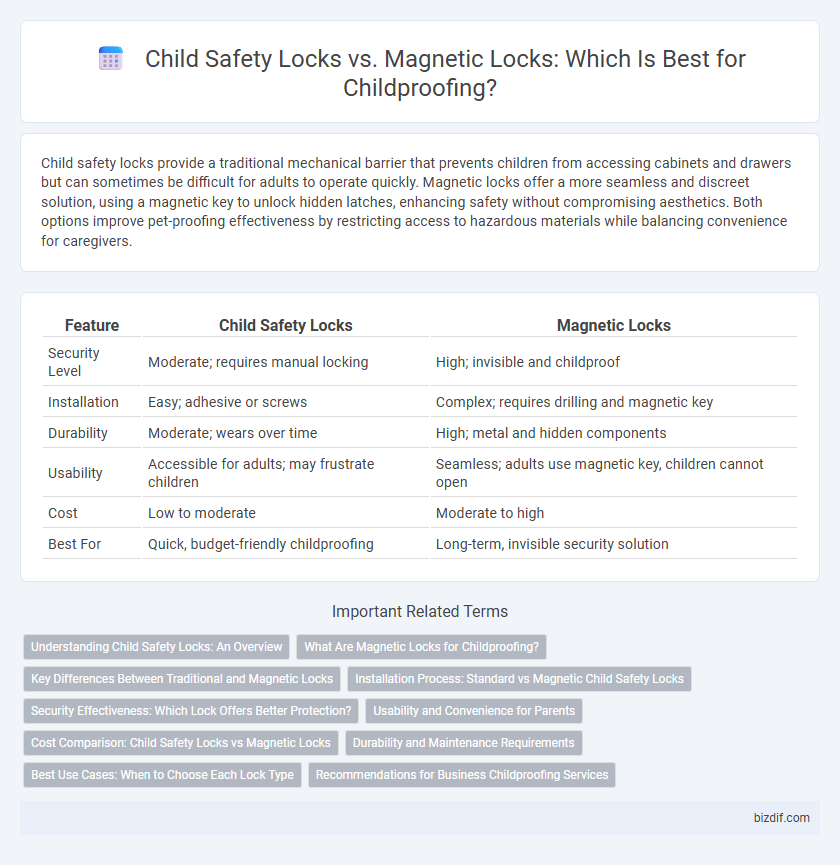Child safety locks provide a traditional mechanical barrier that prevents children from accessing cabinets and drawers but can sometimes be difficult for adults to operate quickly. Magnetic locks offer a more seamless and discreet solution, using a magnetic key to unlock hidden latches, enhancing safety without compromising aesthetics. Both options improve pet-proofing effectiveness by restricting access to hazardous materials while balancing convenience for caregivers.
Table of Comparison
| Feature | Child Safety Locks | Magnetic Locks |
|---|---|---|
| Security Level | Moderate; requires manual locking | High; invisible and childproof |
| Installation | Easy; adhesive or screws | Complex; requires drilling and magnetic key |
| Durability | Moderate; wears over time | High; metal and hidden components |
| Usability | Accessible for adults; may frustrate children | Seamless; adults use magnetic key, children cannot open |
| Cost | Low to moderate | Moderate to high |
| Best For | Quick, budget-friendly childproofing | Long-term, invisible security solution |
Understanding Child Safety Locks: An Overview
Child safety locks feature mechanical latches that prevent children from opening cabinets, drawers, and appliances, ensuring secure access control in the home. Magnetic locks use hidden magnetic mechanisms activated by a special key, offering a discreet and tamper-resistant solution ideal for modern safety needs. Both options enhance childproofing efforts by reducing the risk of accidents, but magnetic locks provide added convenience and aesthetic benefits without compromising security.
What Are Magnetic Locks for Childproofing?
Magnetic locks for childproofing use a hidden mechanism that requires a magnetic key to open, preventing children from accessing cabinets and drawers. These locks are installed inside furniture, making them invisible and maintaining aesthetic appeal while ensuring safety. Compared to traditional child safety locks, magnetic locks provide a more discreet and tamper-proof solution to keep hazardous items out of reach.
Key Differences Between Traditional and Magnetic Locks
Child safety locks typically rely on mechanical latches requiring manual disengagement, while magnetic locks use concealed magnets activated by specific magnetic keys, offering enhanced tamper resistance. Traditional locks often involve visible components prone to wear and tear, whereas magnetic locks provide a sleek, hidden mechanism reducing the risk of accidental openings. Magnetic locks demonstrate superior ease of use for parents combined with increased security against child tampering compared to conventional child safety locks.
Installation Process: Standard vs Magnetic Child Safety Locks
Standard child safety locks typically require drilling holes and screwing components into cabinets or drawers, involving time-consuming installation and potential surface damage. Magnetic child safety locks offer a non-invasive installation with adhesive backing, allowing easy placement and removal without tools or alterations to furniture. Magnetic locks require a compatible magnetic key to unlock, streamlining usability while preserving the aesthetic integrity of furniture surfaces.
Security Effectiveness: Which Lock Offers Better Protection?
Child safety locks use mechanical barriers to prevent access, providing reliable protection against accidental openings but can often be bypassed by determined children. Magnetic locks require a magnetic key to disengage, offering higher security as they are concealed and less prone to tampering. Magnetic locks consistently outperform traditional child safety locks in preventing unauthorized access and ensuring childproofing effectiveness.
Usability and Convenience for Parents
Child safety locks offer straightforward installation and manual operation, making them a budget-friendly choice but sometimes challenging for parents juggling multiple tasks. Magnetic locks, activated with a special key or magnet, provide a seamless user experience by remaining invisible and inaccessible to children while allowing quick and effortless access for adults. These locks significantly enhance convenience for parents seeking secure yet user-friendly childproofing solutions.
Cost Comparison: Child Safety Locks vs Magnetic Locks
Child safety locks generally cost between $5 and $15 per unit, making them an affordable option for securing cabinets and drawers. Magnetic locks, while more expensive, typically range from $20 to $50 per set but offer enhanced security through hidden installation and keyless operation. Investing in magnetic locks can result in higher upfront costs but provides long-term durability and childproofing effectiveness compared to standard child safety locks.
Durability and Maintenance Requirements
Child safety locks typically offer robust durability with materials like heavy-duty plastic or metal, requiring occasional cleaning and simple battery replacements for electronic models. Magnetic locks, while also durable due to their hidden installation reducing wear and tear, demand periodic alignment checks and battery changes to maintain functionality. Both options minimize long-term maintenance, but magnetic locks generally provide a sleeker, low-maintenance solution ideal for modern childproofing needs.
Best Use Cases: When to Choose Each Lock Type
Child safety locks are ideal for preventing toddlers from accessing cabinets and drawers containing hazardous materials in kitchens and bathrooms, offering a straightforward installation and mechanical reliability. Magnetic locks excel in environments where aesthetics and full concealment are priorities, as they remain invisible from the outside and are best suited for cabinets that require frequent access by adults but need to stay off-limits to children. Choosing between these locks depends on balancing ease of use, frequency of access, and the need for discreet childproofing solutions.
Recommendations for Business Childproofing Services
Business childproofing services should prioritize magnetic locks over traditional child safety locks due to their enhanced security features and ease of use for adults. Magnetic locks provide a tamper-proof solution, reducing the risk of accidental access to hazardous areas, making them ideal for environments with high child traffic. Investing in magnetic locking systems demonstrates a commitment to advanced safety standards and client reassurance.
Child safety locks vs Magnetic locks Infographic

 bizdif.com
bizdif.com